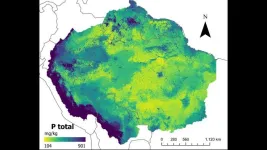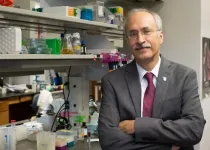(Press-News.org) DURHAM, N.C. -- Look closely at Impressionist paintings in museums compared with photos of them taken 50 years ago, and you might notice something odd: some are losing their bright yellow hues.
Take the dramatic sunset in Edward Munch’s famous painting “The Scream.” Portions of the sky that were once a vivid orangish yellow have faded to off-white.
Likewise, some of the sunny yellow that Henri Matisse brushed between the reclining nudes in his painting “The Joy of Life” is now more of a drab beige.
Several other paintings from this period are facing similar issues. The bright yellow paint these artists used was made from the chemical compound cadmium sulfide. The pigment was beloved by many European artists of the late 19th and early 20th centuries. Claude Monet, Vincent van Gogh, and Pablo Picasso all brushed their canvasses with it.
“So many painters really loved this pigment,” said Yue Zhou, who earned her Ph.D. in the lab of Duke chemistry professor Warren Warren.
But as the decades passed, many artists and art conservators realized they had a problem: Their cadmium yellow brushstrokes didn’t look as vibrant as they once did.
The passage of time exposes artwork to light, moisture, dust and other elements of nature that can make pigments vulnerable to fading and discoloration.
In a new study, Duke University researchers show that a laser microscopy technique they developed could offer a means of early detection, making it possible to identify the first tiny signs of color change even before they’re visible to the eye.
Several techniques exist to study what pigments were used in a painting and how much they’ve broken down. But they typically involve scraping off a tiny chip of paint with a scalpel to analyze its composition. That method can damage the piece and limits the area to be studied, Zhou said.
“It's a little like surgery,” she added.
Enter pump-probe microscopy. It can peer into layers of paint and detect chemical changes that mark the onset of a pigment’s decay, without taking cross-sections of the original artwork.
The technique uses ultra-fast pulses of harmless visible or near-infrared light, lasting less than a trillionth of a second, and measures how they interact with pigments in the paint. The resulting signals can be used as chemical fingerprints to identify which compounds are present.
By focusing the laser beam at different locations and depths within the sample, the researchers are able to create 3D maps of certain pigments and monitor what’s happening at scales as small as a hundredth of a millimeter.
For the new study, published April 26 in the Journal of Physics: Photonics, the researchers used pump-probe microscopy to analyze samples of cadmium yellow paint subjected to an artificial aging process.
In a lab on Duke’s west campus, Zhou stirred up samples of the famous color. Taking a bottle of powdered cadmium sulfide pigment off a shelf, she mixed it with linseed oil and then brushed it on microscope slides to dry.
Some samples were left in a dark and dry environment, protected from moisture and light damage. But the rest were placed in a special chamber and exposed to light and high humidity -- factors known to wreak havoc on unstable colors.
The researchers then imaged the paint samples using pump-probe microscopy to track the degradation progress on a microscopic scale.
Compared with control samples, the samples that got the aging treatment emerged looking the worse for wear. After four weeks in the aging chamber, they had faded to lighter shades of yellow.
But even before these changes became noticeable, clear signs of decay were already apparent in the pump-probe data, Zhou said.
The cadmium sulfide signal started to wane as early as week one, eventually decreasing by more than 80% by week four.
The signal loss is a result of chemical changes in the pigments, Zhou said. Moisture triggers the transformation of cadmium sulfide, which is yellow, into cadmium sulfate, which is white -- resulting in a whitish or dull cast.
Senior co-authors Warren and Martin Fischer originally developed the technique to analyze pigments in human tissue, not works of art -- to inspect skin moles for signs of cancer. But then they realized the same approach could be used for art conservation.
There is a caveat: while the technique spots early changes in a nondestructive way, conservators can’t easily recreate the bulky laser setup in their own museums.
In the future, the team says it might be possible to develop a cheaper, more portable version that can be used to study paintings that are too vulnerable or large to transport and analyze off site.
Of course, any color loss that has already happened can’t be reversed. But one day, art conservators might have a new tool to spot these changes earlier and take steps to slow or stop the process in its beginning stages.
The research has potential applications beyond artists’ pigments. Looking at cadmium yellow degradation in century-old paintings could help researchers better understand modern materials that are vulnerable to the elements too, such as the cadmium sulfide used in solar cells, Warren said.
This research was supported by grants from the National Science Foundation (CHE-2108623) and from the Chan Zuckerberg Initiative (2021242921).
CITATION: "Non-Destructive Three-Dimensional Imaging of Artificially Degraded CdS Paints by Pump-Probe Microscopy," Yue Zhou, David Grass, Warren S. Warren, and Martin C. Fischer. Journal of Physics: Photonics, April 14, 2024. DOI: 10.1088/2515-7647/ad3e65
END
Laser imaging could offer early detection for at-risk artwork
Time is robbing some historical paintings of their yellow colors. Technique could spot the first signs of fading before they’re visible to the eye
2024-04-29
ELSE PRESS RELEASES FROM THIS DATE:
"BioBlitz" citizen science reveals urban biodiversity, guides management
2024-04-29
Citizen scientists are uncovering rare animal, plant, and fungi species in areas where they have never been seen before, increasing our knowledge of urban biodiversity and proving the existence of local species long thought extinct. The approach used is called a BioBlitz, a biological census in which citizen scientists contribute photographs or audio of living organisms they can see or hear in a designated area over a particular period, creating a snapshot of an area’s biodiversity.
In a recently published article in the journal BioScience, Dr. Esti Palma (University of Melbourne) ...
Haiti study suggests early-onset heart failure is prevalent form of heart disease in low-income countries
2024-04-29
Early-onset heart failure is alarmingly common in urban Haiti—over 15-fold higher than previously estimated—according to a study conducted by Weill Cornell Medicine researchers in partnership with the Haitian medical organization GHESKIO. Heart failure occurs when the heart muscle can no longer pump an adequate amount of blood throughout the body.
The study indicates that the nature of cardiovascular disease in Haiti, and perhaps other low- and middle-income nations, differs from wealthier countries where ischemic heart disease, also called coronary heart disease, is prevalent. This condition, ...
Maps developed with artificial intelligence confirm low levels of phosphorus in Amazonian soil
2024-04-29
As the impacts of climate change increasingly affect the daily lives of residents in several countries, including Brazil, the resilience of forests, especially tropical ones such as the Amazon, has become a frequent topic of research. In addition to studying various factors that influence the way vegetation reacts to global warming, scientists are seeking to improve vegetation models – tools that play a crucial role in understanding and managing ecosystems, contributing to biodiversity conservation and sustainable development.
And it is exactly this combination that is described in research published in the journal Earth System Science Data by a group associated ...
Uptick in NYC transit assault rate during COVID pandemic; has not returned to pre-pandemic levels despite subway safety plan
2024-04-29
April 29, 2024-- Has the New York City subway become less safe? This is the question Columbia University Mailman School of Public Health researchers sought to answer in their newest paper investigating rates of complaints to and arrests by the New York City Police Department Transit Bureau. The findings showed that anxieties related to crime on New York City transit rose following NYC’s COVID-19 pandemic state of emergency declaration in 2020, leading to declines in subway ridership. The results are published in the journal Injury Epidemiology.
The ...
Hongbo Chi, PhD named 2023 AAAS Fellow
2024-04-29
(MEMPHIS, Tenn., April 29, 2024)- Hongbo Chi, PhD, a faculty member and the Robert G. Webster Endowed Chair in Immunology at St. Jude Children’s Research Hospital, has been recognized as a fellow of the American Association for the Advancement of Science (AAAS), the world’s largest general scientific society and publisher of the Science Family of Journals. Chi will be formally inducted Sept. 21, during the organization’s annual Fellows Forum in Washington D.C.
Chi is the most recent St. Jude faculty member selected as an AAAS Fellow. Other St. Jude honorees include: Thirumala-Devi Kanneganti, PhD, Victor Torres, PhD, Douglas Green, PhD, Charles Rock, ...
Study finds school entry requirements linked to increased HPV vaccination rates
2024-04-29
WINSTON-SALEM, N.C. – April 29, 2024 – A new study from researchers at Wake Forest University School of Medicine shows that school entry requirements are linked to an increase in human papillomavirus (HPV) vaccinations.
The findings appear online in Pediatrics.
HPV is a common sexually transmitted infection, which can cause health problems such as genital warts and certain cancers. To prevent infection, the Centers for Disease Control and Prevention (CDC) recommend that 11- to 12-year-olds receive two doses of the HPV vaccine, given 6 to 12 months apart. However, CDC data from 2022 ...
Study reveals higher injury and assault rates among NYC food delivery gig workers dependent on the work
2024-04-29
A study published Monday in the Journal of Urban Health by a team of CUNY researchers finds that food delivery gig workers in New York City face a high risk of injury and assault, particularly those dependent on gig work as their main job. The study analyzes data from a survey of 1,650 delivery workers, collected between October and December 2021 by the New York City Department of Consumer and Worker Protection.
Alarmingly, about 22% reported experiencing injuries, and 21% reported assaults while on the job, with those using e-bikes or mopeds more than twice as likely to be injured or assaulted compared to those who deliver by car.
Of particular importance was the relationship ...
Kaposi sarcoma discovery could facilitate drug development
2024-04-29
Researchers at UNC Lineberger Comprehensive Cancer Center, after decades of research efforts, have developed a mouse model of Kaposi sarcoma that could be key to the development of new drugs to treat the disease. Kaposi sarcoma is a cancer that is the most common cancer in people living with HIV.
The findings appeared in Cell Host & Microbe.
“This is an important development as we have created the first animal model ever of Kaposi sarcoma. Animal models are essential to move new drugs from the laboratory bench into clinical trials,” said UNC Lineberger’s Dirk Dittmer, PhD, senior corresponding author, co-leader of the UNC Lineberger Virology ...
Research shows link between pollution and heart risks in residents of the city of São Paulo, Brazil
2024-04-29
The relationship between living in a polluted city like São Paulo (Brazil) and lung disease or cancer is well known. But the problems go further. Unprecedented research shows that long-term exposure to air pollution is directly linked to increased heart risks in residents of the capital of the state of the same name. People with high blood pressure are at even greater risk.
The study, published in the journal Environmental Research, was conducted by researchers from the University of São Paulo (USP) with support from FAPESP (projects 13/21728-2, 16/23129-7 and 19/06435-5). The research shows ...
Rice’s Yousif Shamoo elected AAAS fellow
2024-04-29
Rice University bioscientist Yousif Shamoo has been elected a fellow of the American Association for the Advancement of Science (AAAS), the world’s largest general scientific society and publisher of the journal Science.
The lifetime honor, one of the highest in the scientific community, is accorded to fewer than 1% of AAAS members each year. Shamoo, the Ralph and Dorothy Looney Professor in the Department of Biosciences, was recognized “for distinguished contributions to research on multidrug resistance, protein structure ...
LAST 30 PRESS RELEASES:
What determines the fate of a T cell?
Candida auris: genetic process revealed which could be treatment target for deadly fungal disease
Groundbreaking discovery turns household plastic recycling into anti-cancer medication
Blocking a key inflammatory pathway improves liver structure and vascular function in cirrhosis, study finds
Continuous spread: Raccoon roundworm detected in nine European countries
HKUST Engineering researchers developed a novel photodetector to enhance the performance of on-chip light monitoring
Strategic river sensors could have forewarned of Texas Camp flood disaster
Drone sampling of whale breath reveals first evidence of potentially deadly virus in Arctic
Roman soldiers defending Hadrian’s Wall infected by parasites, study finds
Pinochet’s prisoners were tormented with music but still found solace in it, a new book reveals
Fertility remains high in rural Tanzania despite access to family planning
AI-assisted device can improve autism care access
Kinetic careers
Uncovering how parasitic plants avoid attacking themselves to improve crop resistance
Nanoparticle vaccine strategy could protect against Ebola and other deadly filoviruses
Study finds brain care score can predict risk of stroke across racial groups
Key lung immune cells can intensify allergic reactions
Do hormones explain why women experience more gut pain?
New materials conduct ions in solids as easily as in liquids
Breakthrough of the Year: Renewable energy begins to eclipse fossil fuel-based sources
LLM use is reshaping scientific enterprise by increasing output, reducing quality and more
Introducing LightGen, a chip for ultra-fast, ultra-efficient generative AI
Astronomers see fireworks from violent collisions around nearby star
ACC/AHA issue new guideline on managing congenital heart disease in adults
Cosmic crash caught on camera
Is talented youth nurtured the wrong way? New study shows: top performers develop differently than assumed
Ants: An untapped resource in the development of antibiotics?
Archaeologists use AI to create prehistoric video game
Mitochondria migrate toward the cell membrane in response to high glucose levels
Tiny viral switch offers hope against drug-resistant bacteria
[Press-News.org] Laser imaging could offer early detection for at-risk artworkTime is robbing some historical paintings of their yellow colors. Technique could spot the first signs of fading before they’re visible to the eye


